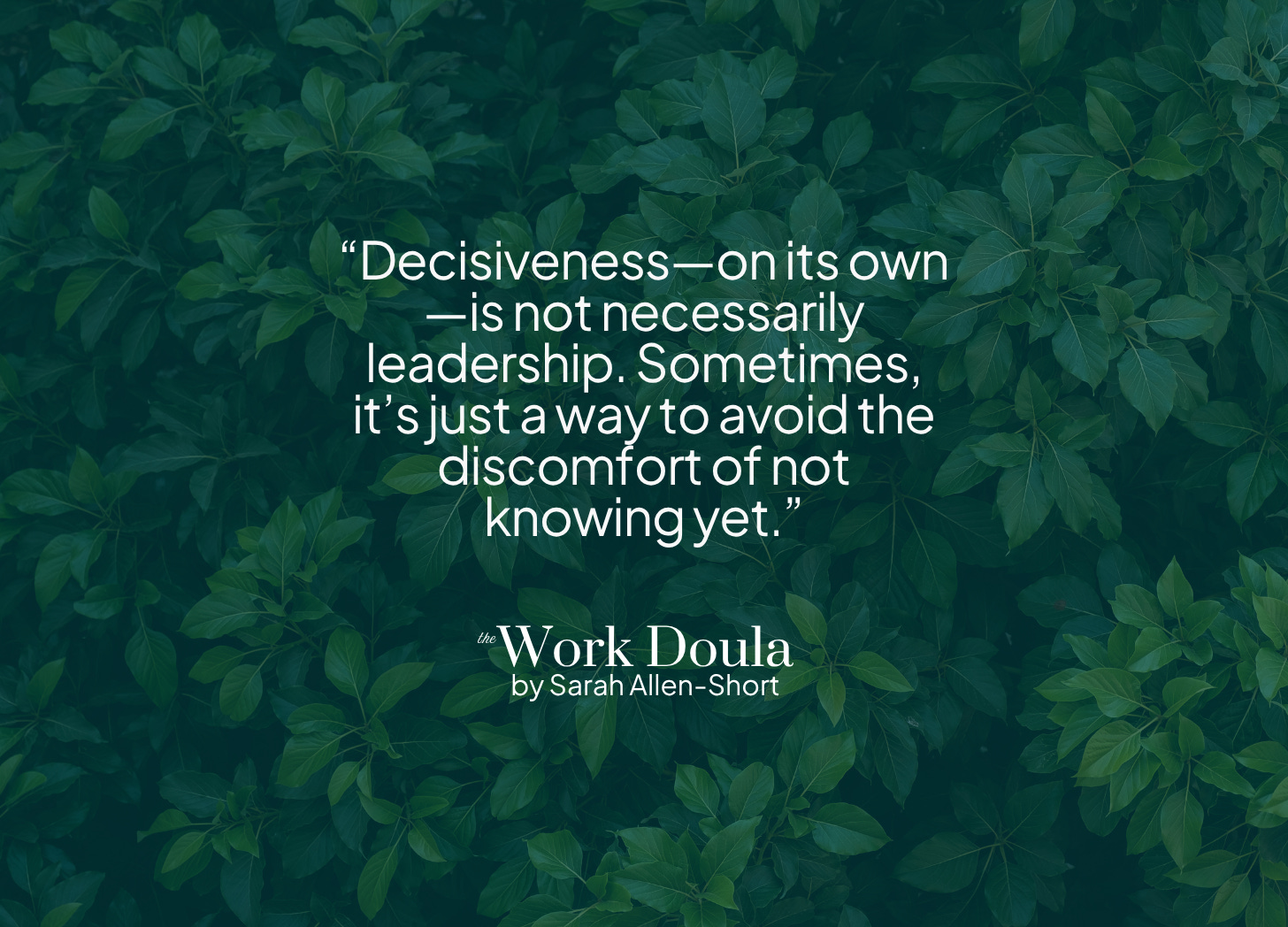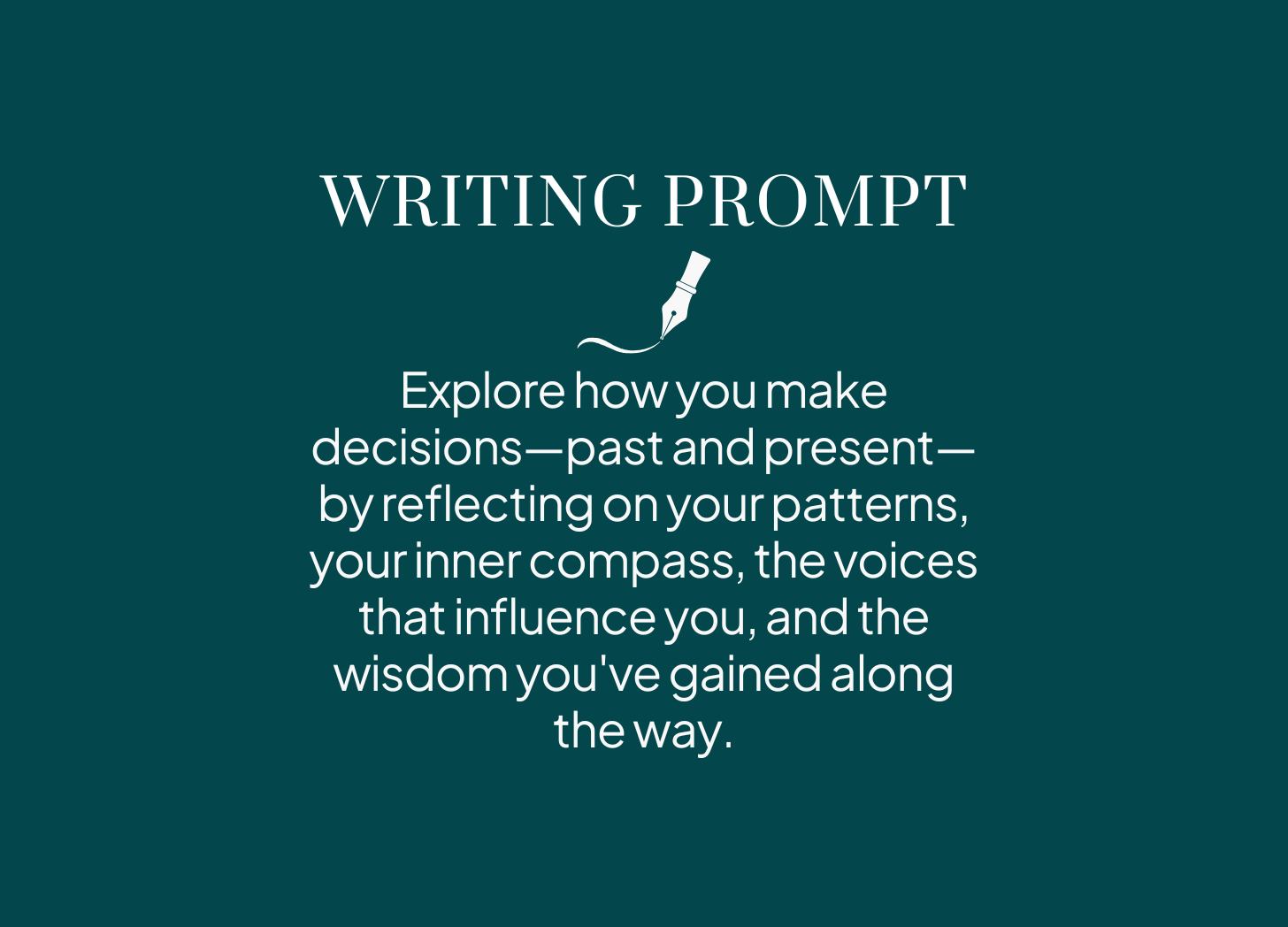Decisiveness is Not Necessarily Leadership
What I'm learning about urgency, duality, and holding the uncomfortable middle
I just wrapped up teaching two cohorts of Inner Compass for Leaders, a course I designed for Pavilion. One week, we explored decision-making—a topic often seen as a hallmark of strong leadership. But as the conversations unfolded, what came to the surface wasn’t strategy or confidence.
It was fear. Fear of being wrong, sitting in uncertainty, not being decisive enough, not having enough experience or information to make good decisions in a chaotic world that is changing moment by moment.
We’re told that great leaders are decisive. That quick action signals confidence and clarity. But decisiveness—on its own—is not necessarily leadership. Sometimes, it’s just a way to avoid the discomfort of not knowing yet.
That’s certainly been true for me.
When Action Becomes Avoidance and the Myth of Failing Fast
When I’m not sure what to do, I rush into action.
Not necessarily thoughtful action. Not aligned, intentional action. Just… action.
The kind that quiets the discomfort. The kind that lets me feel in control.
It doesn’t even have to be the right decision. I just need it to be a decision.
Send the email. Make the call. Say yes. Say no.
Move. Decide. Do something.
This impulse is only reinforced by the popular business mantra: fail fast. We're told that speed is a virtue. That action, even if it's wrong, is better than hesitation. And sometimes, that’s true. But for those of us who already move too quickly, “fail fast” doesn’t encourage bold experimentation. It just gives our discomfort a new disguise. It tells us that movement is always progress, when sometimes, it’s just avoidance, wearing a badge of productivity.
It appears to be competence from the outside. But inside? I’m just trying to get away from the squirmy feeling of not knowing wtf to do next or how to do it.
Not All Leaders Need the Same Medicine
When I was in my twenties, one of my closest friends and I were both in therapy at the same time. One evening, sharing a room at a lake house and talking late into the night, we discovered our therapists were giving us conflicting information.
My therapist told me I needed to stop acting and spend more time in consideration.
Hers told her she needed to stop overthinking and take more action.
We spent months wondering whose therapist was “right.” Should I be more like her or should she be more like me?
The answer, of course, was BOTH. We didn’t need the same advice. We needed different truths.
The right advice depends on your patterns, your history, and your default mode under pressure. It never occurred to us that leadership, like therapy, isn’t one-size-fits-all.
Now, more than 25 years later, I’m still learning to slow down, and I can see how my habit of rushing into action is a coping mechanism.
When a situation feels murky or emotionally tense or uncertain, I want it resolved.
But here’s what I’m learning:
Discomfort is not an emergency.
Just because something feels urgent doesn’t mean it is urgent.
Just because I CAN act fast doesn’t mean I SHOULD.
Pausing Isn’t Weakness; It’s Wisdom
These days, I’m trying something different. I’m learning to pause—not forever, and not passively—but just long enough to let discomfort be what it is: discomfort, not danger. Long enough to resist the pull toward premature certainty and instead ask better questions before jumping to answers.
It’s uncomfortable, yes. But it’s not the kind of discomfort that signals a mistake. It’s the kind that signals a shift. A breaking of the pattern.
We often confuse speed with strength. However, some of the strongest leaders I know are those who are willing to wait, hold space for the unknown, and lead from a place of presence rather than performance.
So if you find yourself rushing to decide, to fix, to move—maybe pause. Notice what you’re trying to get away from. And ask yourself: Is this real clarity, or just the performance of decisiveness?
Because decisiveness is not necessarily leadership. But discernment? That’s the work.
Writing Prompts
Want to explore your own decision-making patterns?
Here are two journaling exercises I use with coaching clients and workshop groups to start making better decisions from a place of self-trust and grounded awareness
1. What is your decision-making origin story?
Take 10 minutes to reflect on your personal history with decision-making. Use the questions below as guideposts—you don’t have to answer them all. Follow what feels rich, interesting, or revealing to you.
Part 1: Your Patterns
When you look back, how would you describe your relationship with decision-making?
Do you tend to decide quickly or slowly? Alone or with input? With data or intuition?
Have you historically trusted yourself—or outsourced your knowing to others?
Part 2: A Gut-Based Decision
Recall one time you followed your gut—maybe even when the facts didn’t line up.
What gave you the courage or clarity to trust your instinct?
What happened next?
What did that experience teach you about your inner compass?
Part 3: A Decision You Regret
Think of a decision that still feels sticky or unresolved.
What made that choice feel right—or hard—at the time?
If you could go back, what might you say to yourself with compassion?
What gift did that decision give you, if any?
Part 4: Your Decision-Making Strengths
What do you know for sure about how you make good decisions?
When are you at your most clear and confident?
What strengths do you bring to the table that others might miss in themselves?
How can you rely on those strengths more intentionally?
2. Whose voices are in the room when you make a decision?
When you're on the verge of a big decision—or even a small one—there are often many voices in your head. Some are helpful. Some are loud. Some don’t even belong to you.
Take 10 minutes with these prompts:
The Cast of Characters
Who are the people whose approval you seek (consciously or unconsciously) when making a decision?
Who taught you what “good judgment” looks like?
Who do you fear disappointing?
Are there voices you still carry with you from past jobs, mentors, or even childhood?
The Internal vs. External
Which of these voices are truly yours?
Which voices support your clarity and confidence?
Which ones cloud it?
The Way Forward
What would decision-making look like if you turned down the volume on the voices that aren’t yours?
What do you need to hear more often from yourself?
Work with Me
If you’re navigating the messy, magical, sometimes overwhelming transitions of your company, GTM strategy, and/or professional life, I’d love to support you. Most leaders have plenty of hustle, what they need is support.
I work with visionary founders and GTM leaders on go-to-market strategy, leadership, clarity, and growth. I’d love to chat about what you need.
I also lead “How’s Work” workshops every month, open to all. We use writing prompts to explore decision-making, conflict, career, ambition, leadership, change, and work stress.
We’re on a hiatus for summer, but you can sign up to be notified about fall dates when they are posted.





This is excellent Sarah! I have been working on the last year to take more pauses as I think through decisions. I've had to get comfortable that discomfort is not an emergency. I often want to fix things fast but find that this isn't the right approach..more and more, I take time to lean into the discomfort to see what I uncover and learn.